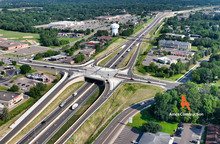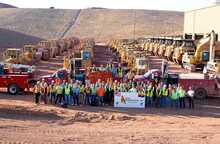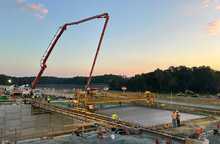Rail Emergency Rapid Response
When a record-breaking flood caused the partial collapse of a BNSF rail bridge over the Big Sioux River, Ames Construction responded with people and equipment to remove the damaged structure.
Heavy rains and severe flooding in late June 2024 destroyed homes, damaged property, and closed roadways and businesses along the Iowa-South Dakota border. Before it was over, the Big Sioux River crested about 7 feet higher than the previous record.
One of the swollen river’s casualties was a BNSF rail bridge. Built in 1903, the bridge consisted of two trusses, 152 feet each. After the bridge partially collapsed on June 23, BNSF turned to Ames to remove the damaged structure from the river.
Ames is a long-time, reliable partner to the railroad industry across the United States. For emergency rail projects, Ames is uniquely diversified to perform the wide variety of tasks needed to get operations back to normal faster.
“For this emergency project, we needed to haul in over 50,000 tons of rock, build levees, conduct the bridge demolition, perform clearing and grubbing, conduct site planning with BNSF and multiple agencies, while focusing on cost control,” says Construction Manager Mike Pamperin. “Ames provided all of the equipment and people needed to work double shifts. We were able to help BNSF take care of all of its needs.”
Bringing down a bridge
On June 29, Ames mobilized to the site, ultimately devoting more than a dozen people along with dozers, excavators, cranes, and other equipment.
In close partnership with BNSF, Ames assessed the situation and developed a work plan to remove the damaged bridge. The center pier had tipped over and was still moving; the truss spans also appeared to be unstable. The group determined that there was no safe way to stabilize the structure in order to dismantle it. The solution was to use explosive demolition to drop the trusses into the river so that they could be safely removed, broken down, and hauled away.
Collaborating with BNSF and Olsson Engineering, Ames obtained permits for working on the levee by Aug. 8. Crews installed causeway access roads prior to the detonations, which were conducted in two operations.
Ames conducted the first controlled detonation on the South Dakota side of the bridge on Aug. 19. The second controlled detonation on the Iowa side was conducted three weeks later, on Sept. 6. Demolition activities were complete by Sept. 13, and Ames demobilized by Sept. 26.
Following the demolition, Ames was awarded the contract to replace the bridge. Construction began in late 2024 and will be complete in 2025.








